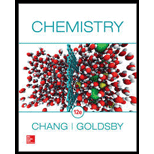
(a) Use the van’t Hoff equation in Problem 14.118 to derive the following expression, which relates the equilibrium constants at two different temperatures:
How does this equation support the prediction based on Le Châtelier’s principle about the shift in equilibrium with temperature? (b) The vapor pressures of water are 31.82 mmHg at 30°C and 92.51 mmHg at 50°C. Calculate the molar heat of vaporization of water.
a)
Interpretation:
The given equation is the prediction based on Le-Chatelier’s principle about the shift in equilibrium with temperature has to be interpreted.
Concept introduction:
Law of mass action: The rate of chemical reaction is directly proportional to the product of concentrations of reactant to products.
Van’t Hoff equation: the change in equilibrium constant,
Clausius-Claypeyron equation:
Explanation of Solution
Let’s write the Van’t Hoff equation at two different temperatures:
At
At
Taking the difference between two equations,
Assuming an endothermic reaction,
b)
Interpretation:
The molar heat of vaporization of water has to be calculated.
Concept introduction:
Law of mass action: The rate of chemical reaction is directly proportional to the product of concentrations of reactant to products.
Multiple equilibria: If a reaction can be expressed as the sum of two or more reactions, the equilibrium constant for the overall reaction is given by the product of the equilibrium constants of the individual reactions.
The equilibrium constant for two separate equilibrium constants are,
For overall reaction, the equilibrium constant
Therefore,
Van’t Hoff equation: the change in equilibrium constant,
Clausius-Claypeyron equation:
Explanation of Solution
For the given reaction,
The given reaction is heterogeneous equilibrium, so, the equilibrium constant expression for gas is,
Rearranging
Given:
Substituting given value into the derived Van’t Hoff equation as,
Therefore, the molar heat of vaporization of water is
Want to see more full solutions like this?
Chapter 14 Solutions
Chemistry
- Name the following molecules with IUpacarrow_forwardWhat is the molecular orbital for cyclopropenyl anion and is it aromatic, antiaromatic or nonaromatic?arrow_forwardUsing the chart describe the change from cystine to tyrosine and its impact on the protein. Using the chart describe the change from histidine to aspartic acid and its impact on the protein.arrow_forward
- How to get the predicted product of this reaction belowarrow_forwardPlease help me fill out the chart then using the chart describe the change from cystine to tyrosine and its impact on the protein. Then using the chart describe the change from histidine to aspartic acid.arrow_forwardWrite the Esterification reaction mechanism for acetic acid, and one propanol to make propanol ethanoate (molecule that gives peas its odor in flavor)arrow_forward
 Chemistry by OpenStax (2015-05-04)ChemistryISBN:9781938168390Author:Klaus Theopold, Richard H Langley, Paul Flowers, William R. Robinson, Mark BlaserPublisher:OpenStax
Chemistry by OpenStax (2015-05-04)ChemistryISBN:9781938168390Author:Klaus Theopold, Richard H Langley, Paul Flowers, William R. Robinson, Mark BlaserPublisher:OpenStax Chemistry: Principles and ReactionsChemistryISBN:9781305079373Author:William L. Masterton, Cecile N. HurleyPublisher:Cengage Learning
Chemistry: Principles and ReactionsChemistryISBN:9781305079373Author:William L. Masterton, Cecile N. HurleyPublisher:Cengage Learning Chemistry: An Atoms First ApproachChemistryISBN:9781305079243Author:Steven S. Zumdahl, Susan A. ZumdahlPublisher:Cengage Learning
Chemistry: An Atoms First ApproachChemistryISBN:9781305079243Author:Steven S. Zumdahl, Susan A. ZumdahlPublisher:Cengage Learning Physical ChemistryChemistryISBN:9781133958437Author:Ball, David W. (david Warren), BAER, TomasPublisher:Wadsworth Cengage Learning,
Physical ChemistryChemistryISBN:9781133958437Author:Ball, David W. (david Warren), BAER, TomasPublisher:Wadsworth Cengage Learning, Chemistry & Chemical ReactivityChemistryISBN:9781337399074Author:John C. Kotz, Paul M. Treichel, John Townsend, David TreichelPublisher:Cengage Learning
Chemistry & Chemical ReactivityChemistryISBN:9781337399074Author:John C. Kotz, Paul M. Treichel, John Townsend, David TreichelPublisher:Cengage Learning Chemistry: The Molecular ScienceChemistryISBN:9781285199047Author:John W. Moore, Conrad L. StanitskiPublisher:Cengage Learning
Chemistry: The Molecular ScienceChemistryISBN:9781285199047Author:John W. Moore, Conrad L. StanitskiPublisher:Cengage Learning





